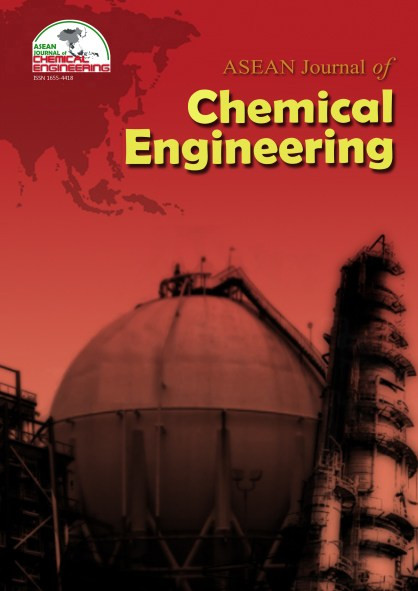Kinetic Study of Subcritical Water Extraction of Carbohydrate from Microalgae Nannochloropsis sp.
Abstract
Microalgae contain a significant amount of carbohydrates that can be converted further to produce valuable compounds. To extract carbohydrates from microalgae, sub-critical water extraction (SWE) is a viable and novel method. Compared to other existing chemical and biological extraction methods, SWE is more economical, effective, and efficient in terms of process conditions. This process uses high temperature and pressure of water at just below supercritical conditions to keep water at a liquid state. This study aims to investigate the factors that affect the extraction yield of carbohydrates from microalgae Nannochloropsis sp. using the SWE process. The extraction was carried out at a temperature of 160 – 320 oC, a duration of 5 – 25 min, and microalgal biomass loading of 5 - 25% w/v. The kinetics study was conducted in an extraction time of 5 – 25 min at 200 oC and 5% (w/v) biomass loading. A simplified kinetic model based on a consecutive reaction was used to describe carbohydrate production and decomposition via SWE. It was found that the maximum yield of total carbohydrate was 18.04 g/100 g which was obtained at 200 oC, 10 min, and 5% (w/v) microalgal biomass loading. The carbohydrate concentration was decreased as the temperature, extraction time and microalgal biomass loading increased. This result indicated that the SWE is a promising extraction method for carbohydrate recovery from microalgae, and the factors investigated here had a significant effect on the extraction process. The proposed kinetic model was also able to capture the experimental data well within the range of operating conditions studied in this work.
References
2. Awaluddin, S. A., Thiruvenkadam, S., Izhar, S., Hiroyuki, Y., Danquah, M. K., & Harun, R. (2016). Subcritical Water Technology for Enhanced Extraction of Biochemical Compounds from Chlorella vulgaris. BioMed Research International, 2016, 1–10. https://doi.org/10.1155/2016/5816974
3. Chan, Y. H., Quitain, A. T., Yusup, S., Uemura, Y., & Sasaki, M. (2017). Optimization of Hydrothermal Liquefaction of Palm Kernel Shell and Consideration of Supercritical Carbon Dioxide Mediation Effect. The Journal of Supercritical Fluids, 1–7. https://doi.org/10.1016/j.supflu.2017.06.007
4. De Morais, M. G., Vaz, B. D. S., De Morais, E. G., & Costa, J. A. V. (2015). Biologically Active Metabolites Synthesized by Microalgae. BioMed Research International, 2015, 1–15. https://doi.org/10.1155/2015/835761
5. Dubois, M., Gilles, K., Hamilton, J. K., Rebers, P. A., & Smith, F. (1951). A colorimetric method for the determination of sugars. Nature, 168(4265), 167. https://doi.org/10.1038/168167a0
6. Huang, R., Cheng, J., Qiu, Y., Zhang, Z., Zhou, J., & Cen, K. (2019). Solvent-Free Lipid Extraction from Microalgal Biomass with Subcritical Water in a Continuous Flow Reactor for Acid-Catalyzed Biodiesel Production. Fuel, 253(January), 90–94. https://doi.org/10.1016/j.fuel.2019.05.004
7. Jin, M., Oh, Y., Chang, Y. K., & Choi, M. (2017). Optimum Utilization of Biochemical Components in Chlorella sp. KR1 via Subcritical Hydrothermal Liquefaction. Sustainable Chemistry&Engineering, 5, 7240–7248. https://doi.org/10.1021/acssuschemeng.7b01473
8. Rogalinski, T., Herrmann, S., & Brunner, G. (2005). Production of Amino Acids from Bovine Serum Albumin by Continuous Sub-Critical Water Hydrolysis. Journal of Supercritical Fluids, 36(1), 49–58. https://doi.org/10.1016/j.supflu.2005.03.001
9. Shahid, A., Khan, F., Ahmad, N., Farooq, M., & Mehmood, M. A. (2020). Microalgal Carbohydrates and Proteins: Synthesis, Extraction, Applications, and Challenges (M. A. Alam, J.-L. Xu, & Z. Wang (eds.)). Springer Nature Singapore. https://doi.org/10.1007/978-981-15-0169-2
10. Tsubaki, S., Onda, A., Hiraoka, M., Fujii, S., Azuma, J. ichi, & Wada, Y. (2017). Microwave-Assisted Water Extraction of Carbohydrates From Unutilized Biomass. In Water Extraction of Bioactive Compounds: From Plants to Drug Development. Elsevier Inc. https://doi.org/10.1016/B978-0-12-809380-1.00007-3
11. Vahabisani, A., Tavakoli, O., & Karbassi, A. R. (2015). The Influence of Acid Hydrolysis on Carbohydrate Extraction from Biomass of Microalgae (C-Vulgaris ). The Influence of Acid Hydrolysis on Carbohydrate Extraction from Biomass of Microalgae (C- Vulgaris), February 2016, 2–6.
12. Yang, L., Qu, H., Mao, G., Zhao, T., Li, F., Zhu, B., Zhang, B., & Wu, X. (2013). Optimization of Subcritical Water Extraction of Polysaccharides from Grifola Frondosa using Response Surface Methodology. Pharmacognosy Magazine, 9(34), 120–129. https://doi.org/10.4103/0973-1296.111262
13. Zainan, N. H., Thiruvenkadam, S., Danquah, M. K., & Harun, R. (2019). Biochemical Analysis and Potential Applications of Aqueous and Solid Products Generated from Subcritical Water Extraction of Microalgae Chlorella pyrenoidosa Biomass. Journal of Applied Phycology, 1–16. https://doi.org/10.1007/s10811-019-01960-0
14. Zhao, G., Chen, X., Wang, L., Zhou, S., Feng, H., Chen, W. N., & Lau, R. (2013). Ultrasound Assisted Extraction of Carbohydrates from Microalgae as Feedstock for Yeast Fermentation. Bioresource Technology, 128, 337–344. https://doi.org/10.1016/j.biortech.2012.10.038
15. Zhu, G., Zhu, X., Fan, Q., & Wan, X. (2011). Kinetics of Amino Acid Production from Bean Dregs by Hydrolysis in Sub-Critical Water. Amino Acids, 40(4), 1107–1113. https://doi.org/10.1007/s00726-010-0734-9
16. Zhu, G., Zhu, X., Xiao, Z., Yi, F., Ma, Y., & Ji, W. (2012). Kinetics of Glucose Production from Cellulose by Hydrolysis in Sub-Critical Water. Advanced Materials Research, 347–353, 2672–2678. https://doi.org/10.4028/www.scientific.net/AMR.347-353.2672
Copyright holder for articles is ASEAN Journal of Chemical Engineering. Articles published in ASEAN J. Chem. Eng. are distributed under a Creative Commons Attribution-NonCommercial 4.0 International (CC BY-NC 4.0) license.
Authors agree to transfer all copyright rights in and to the above work to the ASEAN Journal of Chemical Engineering Editorial Board so that the Editorial Board shall have the right to publish the work for non-profit use in any media or form. In return, authors retain: (1) all proprietary rights other than copyright; (2) re-use of all or part of the above paper in their other work; (3) right to reproduce or authorize others to reproduce the above paper for authors’ personal use or for company use if the source and the journal copyright notice is indicated, and if the reproduction is not made for the purpose of sale.



